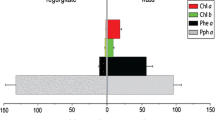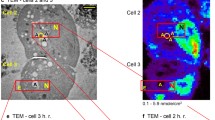Abstract
The main role of the animal gastrointestinal (GI) tract is the selective absorption of dietary nutrients from ingested food sources. One class of vital micronutrients are the essential biometals such as copper, zinc and iron, which participate in a plethora of biological process, acting as enzymatic or structural co-factors for numerous proteins and also as important cellular signalling molecules. To help elucidate the mechanisms by which biometals are absorbed from the diet, we mapped elemental distribution in entire, intact Drosophila larval GI tracts using synchrotron X-ray fluorescence microscopy. Our results revealed distinct regions of the GI tract enriched for specific metals. Copper was found to be concentrated in the copper cell region but also in the region directly anterior to the copper cells and unexpectedly, in the middle midgut/iron cell region as well. Iron was observed exclusively in the iron cell region, confirming previous work with iron-specific histological stains. Zinc was observed throughout the GI tract with an increased accumulation in the posterior midgut region, while manganese was seen to co-localize with calcium specifically in clusters in the distal Malpighian tubules. This work simultaneously reveals distribution of a number of biologically important elements in entire, intact GI tracts. These distributions revealed not only a previously undescribed Ca/Mn co-localization, but also the unexpected presence of additional Cu accumulations in the iron cell region.






Similar content being viewed by others
References
Kuo YM et al (2001) The copper transporter CTR1 provides an essential function in mammalian embryonic development. Proc Natl Acad Sci 98(12):6836–6841
Lee J, Prohaska JR, Thiele DJ (2001) Essential role for mammalian copper transporter Ctr1 in copper homeostasis and embryonic development. Proc Natl Acad Sci 98(12):6842–6847
Dufner-Beattie J et al (2007) The mouse acrodermatitis enteropathica gene Slc39a4 (Zip4) is essential for early development and heterozygosity causes hypersensitivity to zinc deficiency. Hum Mol Genet 16(12):1391–1399
Gunshin H et al (2005) Slc11a2 is required for intestinal iron absorption and erythropoiesis but dispensable in placenta and liver. J Clin Invest 115(5):1258–1266
Nose Y et al (2010) Ctr1 is an apical copper transporter in mammalian intestinal epithelial cells in vivo that is controlled at the level of protein stability. J Biol Chem 285(42):32385–32392
Wang Y et al (2012) Maternofetal and neonatal copper requirements revealed by enterocyte-specific deletion of the Menkes disease protein. Am J Physiol Gastrointest Liver Physiol 303(11):G1236–G1244
Dufner-Beattie J et al (2003) The acrodermatitis enteropathica gene ZIP4 encodes a tissue-specific, zinc-regulated zinc transporter in mice. J Biol Chem 278(35):33474–33481
McMahon RJ, Cousins RJ (1998) Regulation of the zinc transporter ZnT-1 by dietary zinc. Proc Natl Acad Sci 95(9):4841–4846
Gulec S, Anderson GJ, Collins JF (2014) Mechanistic and regulatory aspects of intestinal iron absorption. Am J Physiol Gastrointest Liver Physiol 307(4):G397–G409
Cousins RJ (2010) Gastrointestinal factors influencing zinc absorption and homeostasis. Int J Vitam Nutr Res 80(4–5):243–248
Zhou H, Cadigan KM, Thiele DJ (2003) A copper-regulated transporter required for copper acquisition, pigmentation, and specific stages of development in Drosophila melanogaster. J Biol Chem 278(48):48210–48218
Turski ML, Thiele DJ (2007) Drosophila Ctr1A functions as a copper transporter essential for development. J Biol Chem 282(33):24017–24026
Norgate M et al (2006) Essential roles in development and pigmentation for the Drosophila copper transporter DmATP7. Mol Biol Cell 17(1):475–484
Qin Q, Wang X, Zhou B (2013) Functional studies of Drosophila zinc transporters reveal the mechanism for dietary zinc absorption and regulation. BMC Biol 11:101
Wang X, Wu Y, Zhou B (2009) Dietary zinc absorption is mediated by ZnT1 in Drosophila melanogaster. Faseb J 23(8):2650–2661
Bettedi L et al (2011) Iron depletion in the intestines of Malvolio mutant flies does not occur in the absence of a multicopper oxidase. J Exp Biol 214(Pt 6):971–978
Tang X, Zhou B (2013) Ferritin is the key to dietary iron absorption and tissue iron detoxification in Drosophila melanogaster. Faseb J 27(1):288–298
Poulson DF, Bowen VT (1952) Organization and function of the inorganic constituents of the nuclei Exp. Cell Res 2(Supplement):161–180
Mehta A et al (2009) Ferritin accumulation under iron scarcity in Drosophila iron cells. Biochimie 91(10):1331–1334
McNulty M et al (2001) Evidence that a copper-metallothionein complex is responsible for fluorescence in acid-secreting cells of the Drosophila stomach. Cell Tissue Res 304(3):383–389
Poulson DF et al (1952) The copper metabolism of Drosophila. Proc Natl Acad Sci 38(10):912–921
Wessing A, Zierold K, Schafer D (1988) Intracellular storage of sodium and magnesium in Drosophila Malpighian tubules. X-ray microanalysis of native cryosections. Eur J Cell Biol 47(1):1–6
Schofield RM, Postlethwait JH, Lefevre HW (1997) MeV-ion microprobe analyses of whole Drosophila suggest that zinc and copper accumulation is regulated storage not deposit excretion. J Exp Biol 200(Pt 24):3235–3243
Fahrni CJ (2007) Biological applications of X-ray fluorescence microscopy: exploring subcellular topography and speciation of transition metals. Curr Opin Chem Biol 11(2):121–127
De Samber B et al (2010) Element-to-tissue correlation in biological samples determined by three-dimensional X-ray imaging methods. J Anal At Spectr 25:544–553
Finney L et al (2007) X-ray fluorescence microscopy reveals large-scale relocalization and extracellular translocation of cellular copper during angiogenesis. Proc Natl Acad Sci 104(7):2247–2252
Lye JC et al (2011) Detection of genetically altered copper levels in Drosophila tissues by synchrotron X-ray fluorescence microscopy. PLoS One 6(10):e26867
McColl G et al (2012) Caenorhabditis elegans maintains highly compartmentalized cellular distribution of metals and steep concentration gradients of manganese. PLoS One 7(2):e32685
Ralle M et al (2010) Wilson disease at a single cell level: intracellular copper trafficking activates compartment-specific responses in hepatocytes. J Biol Chem 285(40):30875–30883
Paterson D et al (2011) The X-ray fluorescence microscopy beamline at the Australian Synchrotron. AIP Conf Proc 1365:219–222
Kirkham R et al (2010) The Maia spectroscopy detector system: engineering for integrated pulse capture, low latency scanning and realtime processing. AIP Conf Proc 1234:240–243
Ryan CG et al (2005) Nuclear microprobe–synchrotron synergy: towards integrated quantitative real-time elemental imaging using PIXE and SXRF. Nucl Instrum Methods Phys Res B 231:183–188
James SA et al (2011) Quantitative comparison of preparation methodologies for x-ray fluorescence microscopy of brain tissue. Anal Bioanal Chem 401:853–864
He W, Hu Z (2012) The role of the Golgi-resident SPCA Ca(2)(+)/Mn(2)(+) pump in ionic homeostasis and neural function. Neurochem Res 37(3):455–468
Southall TD et al (2006) Novel subcellular locations and functions for secretory pathway Ca2+/Mn2+-ATPases. Physiol Genomics 26(1):35–45
Chi T et al (2015) A Drosophila model identifies a critical role for zinc in mineralization for kidney stone disease. PLoS One 10(5):e0124150
Gutierrez L et al (2010) Zinc accumulation in heterozygous mutants of fumble, the pantothenate kinase homologue of Drosophila. FEBS Lett 584:2942–2946
Selvaraj A et al (2005) Metal-responsive transcription factor (MTF-1) handles both extremes, copper load and copper starvation, by activating different genes. Genes Dev 19(8):891–896
Burke R, Commons E, Camakaris J (2008) Expression and localisation of the essential copper transporter DmATP7 in Drosophila neuronal and intestinal tissues. Int J Biochem Cell Biol 40(9):1850–1860
Acknowledgments
This research was undertaken on the XFM beamline at the Australian Synchrotron, Victoria, Australia. The authors acknowledge experimental assistance from Daryl L. Howard.
Author information
Authors and Affiliations
Corresponding author
Electronic supplementary material
Below is the link to the electronic supplementary material.
Rights and permissions
About this article
Cite this article
Jones, M.W.M., de Jonge, M.D., James, S.A. et al. Elemental mapping of the entire intact Drosophila gastrointestinal tract. J Biol Inorg Chem 20, 979–987 (2015). https://doi.org/10.1007/s00775-015-1281-3
Received:
Accepted:
Published:
Issue Date:
DOI: https://doi.org/10.1007/s00775-015-1281-3




